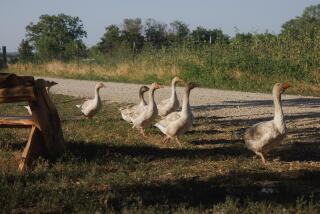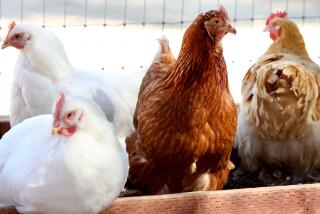Best-laid plans to give chickens room to run are shelved with USDA organics rule
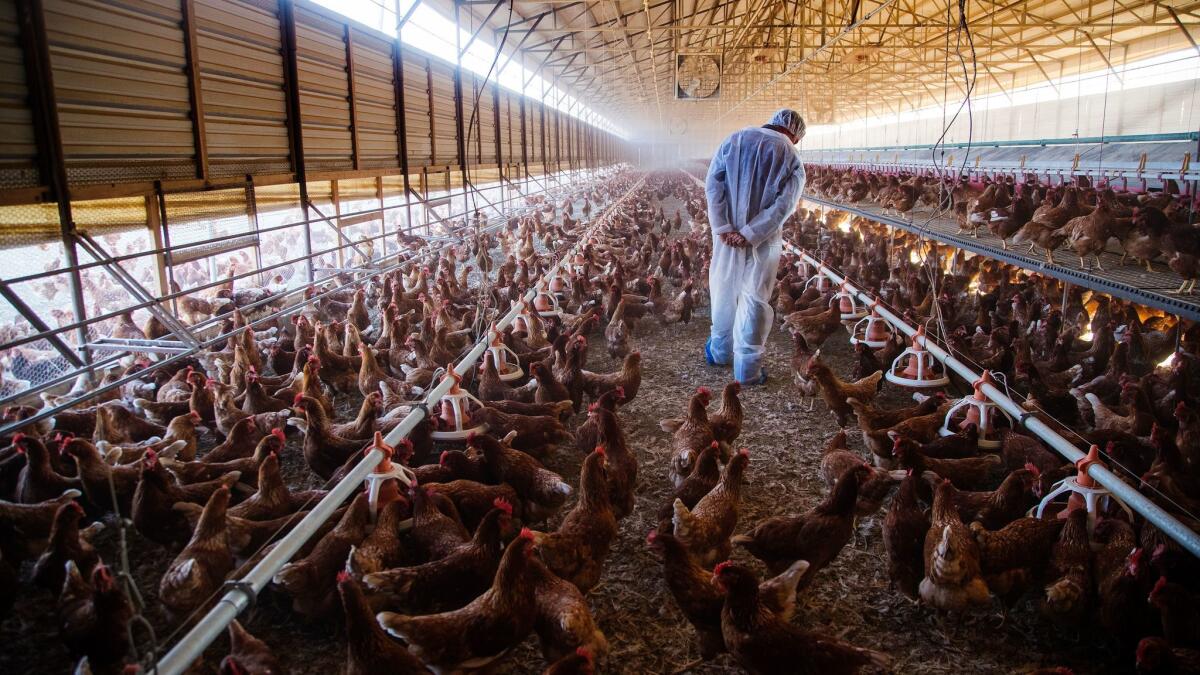
Strolling through a flock of free-roaming rust-colored hens, Christopher Nichols admits that no one truly knows whether his chickens are happier because they can strut around and wander outside.
But consumers are happier, and that matters a lot to the third-generation egg farmer and a slew of other egg producers who charge a premium price for eggs bearing the U.S. Department of Agriculture’s organic certification, which governs not only what hens eat, but nearly everything about how they live their lives.
“The consumers have an idea of what this sort of operation looks like,” Nichols said, raising his voice above the chorus of clucks emanating from more than 7,000 Rhode Island red hybrids at a Nuevo, Calif., ranch that supplies his family company, Chino Valley Ranchers.
“When you give them a building with no windows, no natural light and a screened porch and label it as ‘organic,’ I think they’re going to be a little bit ticked off.”
Those consumers will have to be ticked off for at least another six months. In early November, the USDA quietly shelved a rule that would have given consumers a bit more of what they assume is part of organic eggs — open air.
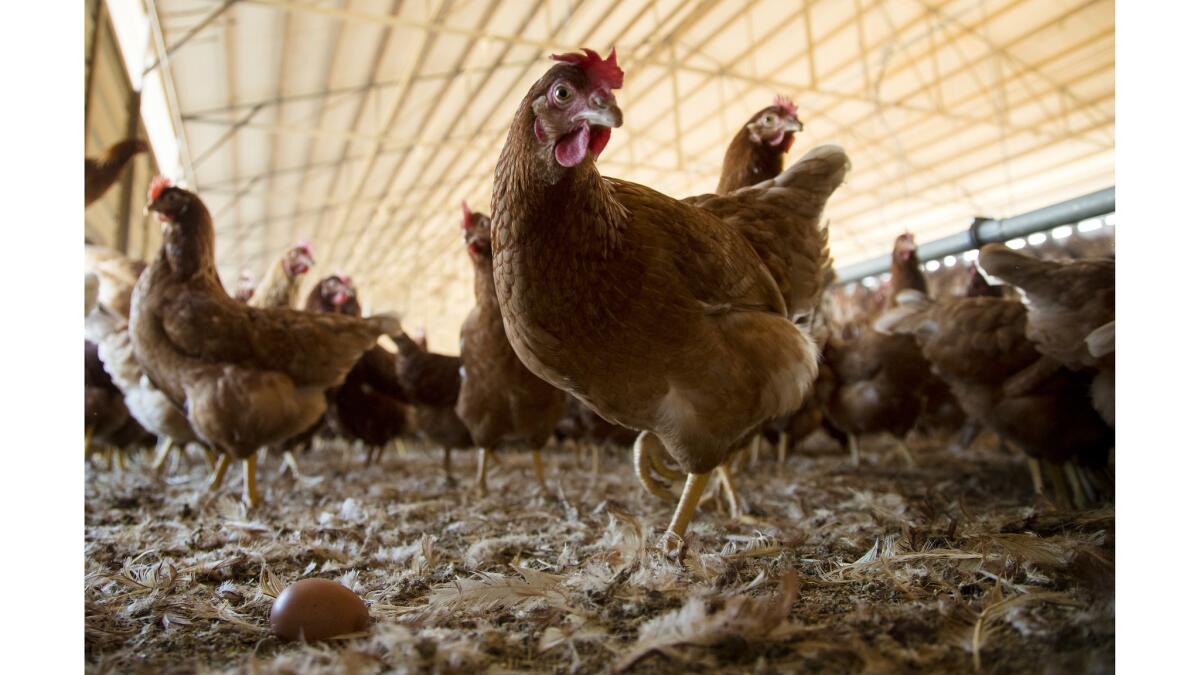
Agriculture Secretary Sonny Perdue (who is not related to the chicken family) left open a loophole in organic regulations that has allowed factory egg farms, some with 100,000 hens to a barn, to earn an organic imprimatur without much more than a nod to letting chickens leave their coop — that is, attaching a gated, screened porch to their barns.
It was the third delay for the obscure but highly contentious rule, which had made it into the Federal Register on the day before President Trump took the oath of office, only to fall victim to his “regulatory freeze” executive order.
The well-being of a laying hen may seem an esoteric concern to the average consumer confronted with a slew of labels that grade eggs and purport to explain how they were laid — free-range, cage-free or pasture-raised, for instance.
But how much space, and what kind, each hen gets is crucial to the $5.5-billion egg industry. Producers owe a good deal of their growth to organic, free-range, cage-free and other marketing labels — more than 13% of the flock is in those niches now, according to the American Egg Board.
Less than a third of those, or about 14.6 million hens, are certified organic — roaming free, with some access to the outdoors, and fed only on grains raised without conventional pesticides or fertilizers.
Organic eggs now fill the refrigerators of big-box stores such as Costco and Wal-Mart. Most of those eggs come from the titans of the egg industry, such as Herbruck’s Poultry Ranch in Michigan and Mississippi-based Cal-Maine.
Those and other egg farms have built their facilities around a 2002 ruling by USDA that allowed farms to attach a screened porch to a chicken barn and qualify it as “outdoor space” under the organic rules. At least a third of organic egg producers operate under that model, according to USDA.
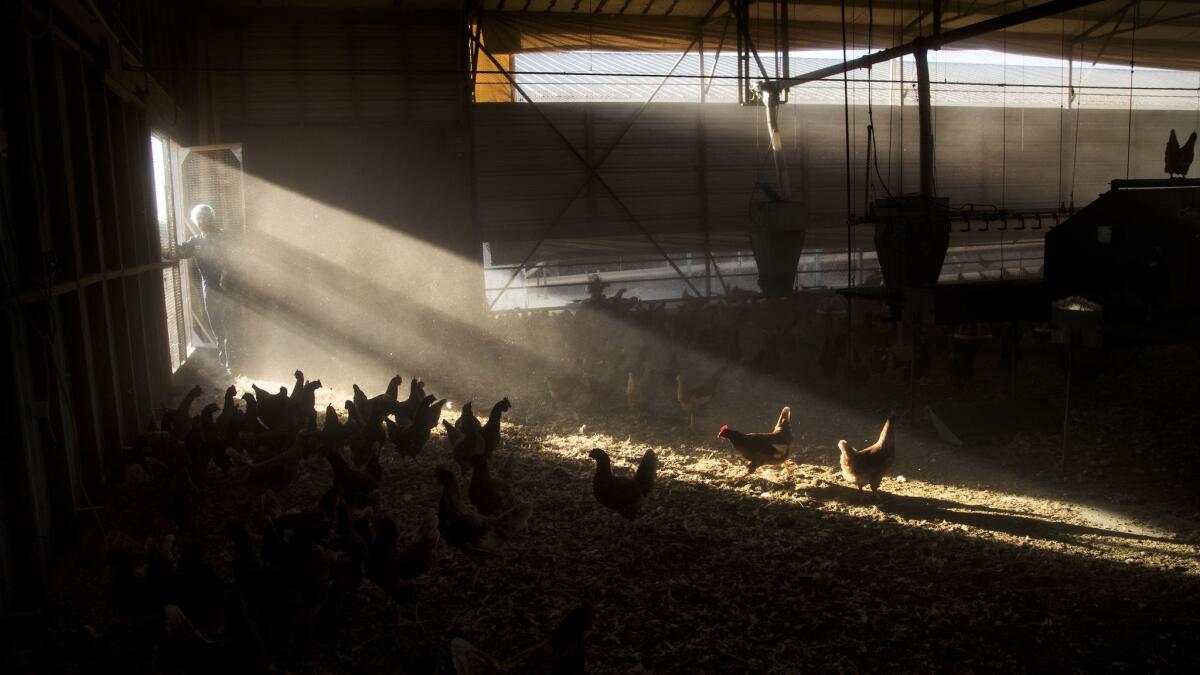
Big egg farms would like to keep it that way, saying any change would drive nearly half of them out of the market and expose birds to disease from wild birds and rodents.
“We are pleased implementation of the rule has been delayed, allowing for more detailed and accurate evaluation of the economic impact of the proposed regulation,” said Oscar Garrison, vice president for food safety and regulatory affairs for United Egg Producers, an industry advocacy group whose members sell about 97% of the eggs in the country.
USDA has said it would cost the industry $8 million to $30 million over about 15 years to comply with the revised organic rules. Consumers would pay an additional 21 to 50 cents per dozen eggs, the agency estimated. (The agency said benefits of the change, including increasing the willingness of consumers to pay more for the certified eggs, are worth $4 million to $50 million.)
But United Egg Producers contends that nearly half the organic producers will simply leave the market, leaving shortages that will drive up prices.
Nichols, who is vice president of Chino Valley Ranchers, isn’t buying it.
“Don’t let them fool you,” he said. “They knew darn well that they were building these buildings out of compliance. And they knew that when this day came, that they were going to have to face this decision. But they probably figured that they had the money and the political muscle to overrule it.”
Smaller producers, he said, “just don’t have that.”

Under the new rules, even Nichols will have to expand some open areas shared by his barns. “We’re OK with that,” he said. “It’s a small price to pay in order to preserve consumer confidence.”
The egg industry has a longer-term strategy in mind when it fights the organic egg rules. Even as scores of restaurants and food companies, including McDonald’s, have pledged to switch to cage-free eggs, the industry is using the federal farm bill process to preempt state efforts to ban cages. So far, these “rotten egg” measures, as opponents dub them, have failed.
In California, a proposition making its way to next year’s ballot would close the cage loopholes left in a 2008 ballot proposition that gave hens more space, but fell short of mandating cage-free farms.
United Egg Producers, meanwhile, has promoted its own certification program with less generous allocation of space, both indoor and out.
Virtually no one in the organic industry expects the Trump administration to side with smaller producers six months from now, when USDA must again decide whether to enforce the rule.
As a preemptive move, the Organic Trade Assn. sued USDA in September over its previous delays — making it difficult for the agency to bow to industry pressure and withdraw the rule while a federal court case is pending.
“It’s not just the egg industry, but commodity livestock interests,” said Laura Batcha, CEO and director of the Organic Trade Assn. “We believe they don’t want to see this go forward, despite the overwhelming majority that supports it.”
More than 40,000 comments were sent to USDA during the rulemaking process, the group noted. The vast majority favored passing it — in part due to consumer form-letter campaigns. Just one comment, from a consumer in Florida, suggested postponement.
Matt Bershadker, president and CEO of the American Society for the Prevention of Cruelty to Animals, said Perdue’s stall was “another example of powerful agribusiness entities trampling vital animal welfare protections.”
Agribusiness, so far, has won important concessions from the Trump administration in its first year in office.
The USDA killed an Obama rule that would have lowered the legal requirements for poultry farms to win legal claims against the large meat companies that contract them to raise chickens.
That angered rural farm groups, which noted that the farm belt heavily supported Trump. The major meat lobbying groups, meanwhile, applauded the move for preventing a rise in legal costs.
Citing privacy concerns, USDA also purged public records regarding the handling and treatment of animals, making them available only through a Freedom of Information Act request. The files were commonly browsed by animal welfare activists tracking puppy mills, animal research and the livestock industry.
Nichols, who tends to stay out of politics, is no fan of regulation. But organic certification is voluntary — farmers opt in because they want the label to mean something to consumers, he said.
Nichols scanned a fenced-off paddock roughly the size of a soccer field, where hens pecked and kicked up dust. In Michigan, where snow and frigid temperatures already have descended, they wouldn’t even be outside, under any definition of the word, he said.
“Happy is a relative term,” he said of the hens. “We just say content. Their needs are met.”
Whether consumers’ needs are met, he added, is an entirely different matter.
Twitter: @LATgeoffmohan
More to Read
Inside the business of entertainment
The Wide Shot brings you news, analysis and insights on everything from streaming wars to production — and what it all means for the future.
You may occasionally receive promotional content from the Los Angeles Times.
